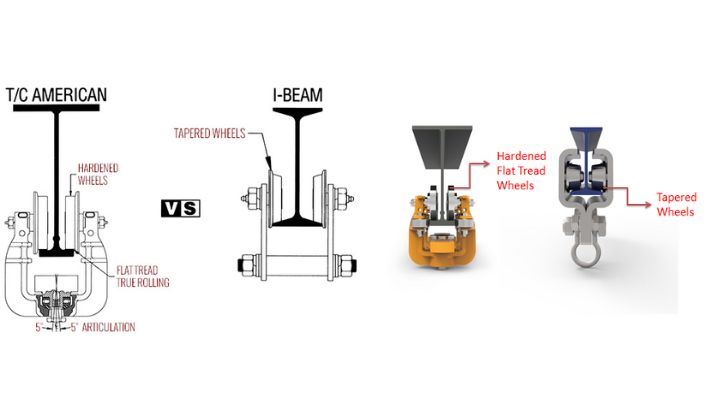
First—What it is Not!
The construction industry relies on heavy, tracked cranes (think ‘crawler crane’) to do a majority of its lifting, most of which is out-of-doors. This is not at all what we are talking about in this article. We are concerned largely with indoor applications in this overview.
Although it’s a critical piece of infrastructure, the majority of business and facility owners who either need or could use one do not really understand them. It’s time to roll back the covers and learn what this is all about.
What is a Patented Track Crane?
In the simplest model, overhead cranes inside facilities and factories derive their mobility through the use of rollers (trolleys) which run along I-beams. It is frequently the easiest solution for moving materials inside of the facility: some sort of trolley runs along the I-beam and carries the material from Point A to Point B, and so on.
The term ‘patented track’ came from an engineering mindset proposing a better idea. Hence, it was granted a patent, and variations of it are in use to this day.
How Does It Work?

The above image from TC American (a patented track crane manufacturer) is a generic comparison of the differences between patented track on the left and a standard track on the right. Here’s the difference at a glance: The standard track is designed to run on a standard I-beam, which is a single piece of steel, with the top and bottom thickness dependent upon the size of the I-beam. The larger the I-beam the thicker the top and bottom pieces are.
“What is the difference between the use of a patented track crane system versus the use of a standard track trolley crane running strictly over an existing I-beam?”
From a distance, they look very similar. However, upon further review, differences can be seen in the above diagrams. The two main components are rails and trolleys. The patented track uses a hardened steel bottom piece, likely 2X the hardness of the standard I-beam, but it is a constant thickness, regardless of the vertical dimension of the beam. This is possible because the hardened rail is a separate piece of steel welded into position. If you look carefully at the diagrams, you can see just above the bottom track there is a bulge in the vertical dimension. That bulge occurs because it is precisely where the bottom hardened steel rail is welded to the upper portion of the I-beam. Patented track gets assembled the same way as standard track, but the parts look a little different.
Main Features and Benefits of a Patented Track Crane
The main feature is a track that is stronger, more precisely machined, and provides a smoother ride for the trolley. The benefits are safety because the track is stronger, less maintenance and repair due to less friction, along with less issues with possible damage to the products being conveyed. There is a definite purpose to this type of track.
Negatives of a Patented Track Crane
Cost would be a consideration because standard track cranes can often be installed by mounting directly on existing infrastructure. It is possible—and common—for trolley systems to utilize existing I-beams, particularly so if the loads and travel distances are not great.
Most Common Applications
When a facility needs to move heavier items from one station to another—particularly if they are somewhat distant from each other and within congested spaces, it often makes sense to install an overhead system to move things efficiently.
How are Patented Track Cranes Categorized?
Throughout this country and the rest of the world, there is no shortage of brands, sizes and capacities of patented track crane rails and trolleys. Fortunately, we can break that down into just the three, most popular, predominant types of designs. Like our overhead cranes, the patented track cranes are categorized by single girder, double girder, and truss crane types.
How Should You Determine Whether Your Company Needs Patented Tracks?
It’s an engineering decision, generally depending upon weights of the loads to be moved, the frequency of cycles (trips) and the spans to be covered. The hard alloy steel can lift loads of up to 40 tons, and then transport them where needed in the facility. These alloy steel runways are precisely machined to very fine tolerances, which help the loads to move as smoothly as possible. And this also minimizes wear on the surfaces over which the trolley travels. That is the main benefit of patented tracks.
Conclusion
Because all crane systems are machines, they experience wear and must be maintained regularly and repaired quickly. As such, availability of parts and service is a critical consideration. Every crane system manufacturer can furnish and install the new equipment being sold. Very few can handle parts and emergency service for all brands like Crane Tech does.




